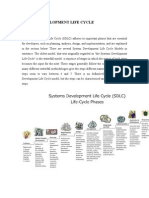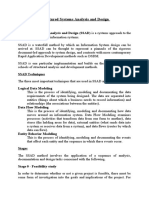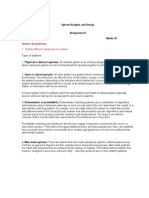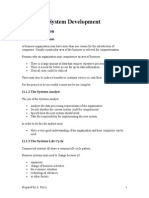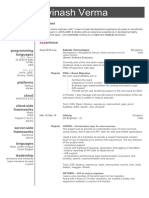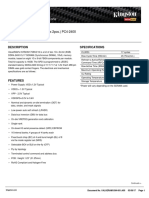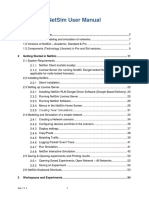0 ratings0% found this document useful (0 votes)
47 viewsMIS Mod 6
MIS Mod 6
Uploaded by
Gautam PkMBA NOTES
Copyright:
© All Rights Reserved
Available Formats
Download as DOCX, PDF, TXT or read online from Scribd
MIS Mod 6
MIS Mod 6
Uploaded by
Gautam Pk0 ratings0% found this document useful (0 votes)
47 views4 pagesMBA NOTES
Original Title
MIS mod 6
Copyright
© © All Rights Reserved
Available Formats
DOCX, PDF, TXT or read online from Scribd
Share this document
Did you find this document useful?
Is this content inappropriate?
MBA NOTES
Copyright:
© All Rights Reserved
Available Formats
Download as DOCX, PDF, TXT or read online from Scribd
Download as docx, pdf, or txt
0 ratings0% found this document useful (0 votes)
47 views4 pagesMIS Mod 6
MIS Mod 6
Uploaded by
Gautam PkMBA NOTES
Copyright:
© All Rights Reserved
Available Formats
Download as DOCX, PDF, TXT or read online from Scribd
Download as docx, pdf, or txt
You are on page 1of 4
MIS (MOD 6)
SYSTEM DEVELOPMENT CYCLE FOR MIS-
Like any other product development, system development requires careful analysis and design
before implementation. System development generally has the following phases:
Planning and Requirement Analysis
The project planning part involves the following steps:
Reviewing various project requests, Prioritizing the project requests, Allocating the resources,
Identifying the project development team, Various techniques used in information system
planning are:, Critical Success Factor, Business System Planning, End/Mean Analysis
The requirement analysis part involves understanding the goals, processes and the constraints
of the system for which the information system is being designed.
It is basically an iterative process involving systematic investigation of the processes and
requirements. The analyst creates a blue print of the entire system in minute details, using
various diagramming techniques like:
Data flow diagrams, Context diagrams, Requirement analysis has the following sub-processes:,
Conducting preliminary investigation, Performing detailed analysis activities, Studying current
system, Determining user requirements, Recommending a solution
Defining Requirements
The requirement analysis stage generally completes by creation of a 'Feasibility Report'. This
report contains:
A preamble, a goal statement. A brief description of the present system, proposed alternatives
in details, The feasibility report and the proposed alternatives help in preparing the costs and
benefits study. Based on the costs and benefits, and considering all problems that may be
encountered due to human, organizational or technological bottlenecks, the best alternative is
chosen by the end-users of the system.
Designing System architecture
System design specifies how the system will accomplish this objective. System design consists
of both logical design and physical design activity, which produce 'system
specification' satisfying system requirements developed in the system analysis stage.
In this stage the following documents are prepared: Detailed specification Hardware/software
plan
Building or Developing the System
The most creative and challenging phase of the system life cycle is system design, which refers
to the technical specifications that will be applied in implementing the candidate system. It also
includes the construction of programmers and program testing.
It has the following stages: Acquiring hardware and software, if necessary Database design
Developing system processes Coding and testing each module
The final report prior to implementation phase includes procedural flowcharts, record layout,
report layout and plan for implementing the candidate system. Information on personnel,
money, hardware, facility and their estimated cost must also be available. At this point
projected cost must be close to actual cost of implementation.
Testing the System
System testing requires a test plan that consists of several key activities and steps for programs,
strings, system, and user acceptance testing. The system performance criteria deals with
turnaround time, backup, file protection and the human factors.
Testing process focuses on both: The internal logic of the system/software, ensuring that all
statements have been tested; the external functions, by conducting tests to find errors and
ensuring that the defined input will actually produce the required results.
In some cases a 'parallel run' of the new system is performed, where both the current and the
proposed system are run in parallel for a specified time period and the current system is used
to validate the proposed system.
Deployment of the System
At this stage, system is put into production to be used by the end users. Sometime, we put
system into a Beta stage where users feedback is received and based one feedback system is
corrected or improved before a final release or official release of the system.
System Evaluation & Maintenance
Maintenance is necessary to eliminate the errors in the working system during its working life
and to tune the system to any variation in its working environment. Often small system
deficiencies are found, as system is brought into operation and changes are made to remove
them. System planner must always plan for resources availability to carry on these maintenance
functions.
SYSTEM ANALYSIS:SYSTEM DESIGN(DFD AND ER DIAGRAM)
ER-D- A popular graphical notational paradigm for representing conceptual models
Has three core constructs
An entity: depicted as a rectangle, represents a collection of real-world objects
that have common properties and behaviours
A relationship: depicted as an edge between two entities, with diamond in the
middle of the edge specifying the type of relationship
An attribute: an annotation on an entity that describes data or properties
associated with the entity
ER diagrams are popular because::they provide an overview of the problem to be addressed the
view is relatively stable when changes are made to the problem's requirements ER diagram is
likely to be used to model a problem early in the requirements
DFD- ER diagram, event trace, state machines depict only lower-level behaviours
A data-flow diagram (DFD) models functionality and the flow of data from one function to
another
A bubble represents a process An arrow represents data flow A data store: a
formal repository or database of information
Rectangles represent actors: entities that provide input data or receive the
output result
Components
A large box: system boundary Stick figures outside the box: actors, both human
and systems
Each oval inside the box: a use case that represents some major required
functionality and its variant
A line between an actor and use case: the actor participates in the use case
Use cases do not model all the tasks, instead they are used to specify user views of
essential system behavior
Advantage:
Provides an intuitive model of a proposed system's high-level functionality and
of the data dependencies among various processes
Disadvantage:
Can be aggravatingly ambiguous to a software developer who is less familiar
with the problem being modelled.
You might also like
- SYSTEM ANALYSIS AND DESIGN Unit 2Document6 pagesSYSTEM ANALYSIS AND DESIGN Unit 2Md HassanNo ratings yet
- SAAD Lecture II - SDLCDocument100 pagesSAAD Lecture II - SDLCKisyenene JamusiNo ratings yet
- System Development Life CycleDocument10 pagesSystem Development Life CycleavndNo ratings yet
- Backend NotesDocument46 pagesBackend Noteschristian MUNEZERO NSHUTINo ratings yet
- Requirement Analysis & SpecificationDocument10 pagesRequirement Analysis & Specificationrajesh_34No ratings yet
- Chapter 4 AISDocument7 pagesChapter 4 AISmohammedNo ratings yet
- HRIMS Development SystemDocument20 pagesHRIMS Development SystemBagambe BarnarbasNo ratings yet
- System Development Life Cycle (SDLC)Document16 pagesSystem Development Life Cycle (SDLC)Tariq Bezinjo100% (1)
- Week 011 ADocument28 pagesWeek 011 AMahmoodAbdul-RahmanNo ratings yet
- System Analysis and DesignDocument11 pagesSystem Analysis and Designvijaymail23100% (1)
- System Analysis and DesignDocument6 pagesSystem Analysis and DesignHoney Gambhir100% (1)
- System Development Life CycleDocument6 pagesSystem Development Life CycleNishanthini JanarthananNo ratings yet
- BBA6th SAD Unit 1Document12 pagesBBA6th SAD Unit 1Shalender VashishtNo ratings yet
- SSADM Is A Waterfall Method by Which An Information System Design Can Be Arrived atDocument12 pagesSSADM Is A Waterfall Method by Which An Information System Design Can Be Arrived atAenna Orra100% (1)
- Defining A SAADDocument5 pagesDefining A SAADRoy ArsenalNo ratings yet
- System Analysis and DesignDocument4 pagesSystem Analysis and DesignRajashekhar B Beedimani100% (1)
- Data FinalDocument22 pagesData FinalMohd ShahidNo ratings yet
- Master of Computer Application (M.C.A.) Semester-III & IVDocument17 pagesMaster of Computer Application (M.C.A.) Semester-III & IVतुमचाच कृष्णाNo ratings yet
- Management Information SystemDocument14 pagesManagement Information SystemRaghav WadhwaNo ratings yet
- Structured Systems Analysis and Design MethodDocument7 pagesStructured Systems Analysis and Design MethodAkash Kumar SinghNo ratings yet
- System Analysis and DesignDocument7 pagesSystem Analysis and DesignGursimar BediNo ratings yet
- What Is A SystemDocument7 pagesWhat Is A SystemRenz_Cossid_8176No ratings yet
- Computer Applications: System Analysis and DesignDocument56 pagesComputer Applications: System Analysis and DesignAbdul HafeelNo ratings yet
- System Development LifecycleDocument29 pagesSystem Development LifecycleNagunuri SrinivasNo ratings yet
- SadDocument11 pagesSadBibash AdhikariNo ratings yet
- SSADM Techniques: Chapter-Design Methogolgy and Techniques Structured Systems Analysis and DesignDocument24 pagesSSADM Techniques: Chapter-Design Methogolgy and Techniques Structured Systems Analysis and DesignFahim MasoodNo ratings yet
- SAAD DAY 2024 Package 1Document31 pagesSAAD DAY 2024 Package 1kashabrams2No ratings yet
- Unit2 FlipclassDocument25 pagesUnit2 FlipclassAakrit NagariNo ratings yet
- Software Engineering Question BankDocument7 pagesSoftware Engineering Question Banksubhapam100% (1)
- Chapter 3 PDFDocument11 pagesChapter 3 PDFAnonymous HUovc6ROH100% (2)
- System Development Life CycleDocument30 pagesSystem Development Life CyclePalika ChopraNo ratings yet
- Se Practical FileDocument58 pagesSe Practical FileDivya Gupta100% (1)
- Answer All Questions.: 1. Explain Different Categories of A SystemDocument23 pagesAnswer All Questions.: 1. Explain Different Categories of A SystemDeepak Aryan100% (3)
- Chapter 3-SDLCDocument6 pagesChapter 3-SDLCShaggYNo ratings yet
- Software Engineering Unit 2Document14 pagesSoftware Engineering Unit 2Yogesh PatilNo ratings yet
- System Development Life CycleDocument6 pagesSystem Development Life CycleMoujahed AliNo ratings yet
- System Analysis and DesignDocument7 pagesSystem Analysis and DesignAmulioto Elijah MuchelleNo ratings yet
- Documentation of Conceptual DesignDocument11 pagesDocumentation of Conceptual DesignRini ShahNo ratings yet
- Janu Jaiswal's MISDocument33 pagesJanu Jaiswal's MISFikir CaNo ratings yet
- SDLCDocument7 pagesSDLCmohammadfaizamatNo ratings yet
- Chapter 2 System Analysis and Design - SDLC Phases IntroductionDocument5 pagesChapter 2 System Analysis and Design - SDLC Phases Introductionjohntong440No ratings yet
- Clinical Information SystemDocument14 pagesClinical Information SystemFilamae Jayahr CadayNo ratings yet
- Computer Applications System Analysis and DesignDocument67 pagesComputer Applications System Analysis and DesignLalrinchhana KhiangteNo ratings yet
- Software Development Life Cycle (SDLC)Document52 pagesSoftware Development Life Cycle (SDLC)sandhyaNo ratings yet
- Chapter1 System DevelopmentDocument18 pagesChapter1 System DevelopmentJohn Wanyoike MakauNo ratings yet
- System Development NOTESDocument14 pagesSystem Development NOTESMatt PrestonNo ratings yet
- System DevelopmentDocument4 pagesSystem DevelopmentSayed HossainNo ratings yet
- Mis 3Document62 pagesMis 3Monika ParmarNo ratings yet
- Bitew SAD Chapter 1-2Document58 pagesBitew SAD Chapter 1-2baslealgetaneh2No ratings yet
- Report On Software Development Life CycleDocument12 pagesReport On Software Development Life CycleShailu SinghNo ratings yet
- System Development LifecycleDocument29 pagesSystem Development LifecycleSushant SinghNo ratings yet
- System DesignDocument6 pagesSystem DesignrituNo ratings yet
- Banking System Account Opening InterestDocument18 pagesBanking System Account Opening InterestSourav BrahmaNo ratings yet
- Chapter Three: System Development Life Cycle (SDLC)Document10 pagesChapter Three: System Development Life Cycle (SDLC)Gemechis Lema100% (1)
- COM 125 Introduction To System Analysis and Design Lecture Note 4Document7 pagesCOM 125 Introduction To System Analysis and Design Lecture Note 4fcbolarinNo ratings yet
- KMBIT05 - SAD - Unit 3 - Requirement Specification - Alok Singh - Sem4Document35 pagesKMBIT05 - SAD - Unit 3 - Requirement Specification - Alok Singh - Sem4AsHish KasHyapNo ratings yet
- Banking System ProjectDocument13 pagesBanking System ProjectParamjit SinghNo ratings yet
- Chapter 3-SDLC and MethodologiesDocument21 pagesChapter 3-SDLC and Methodologies07dkarkeNo ratings yet
- System Development Life CycleDocument8 pagesSystem Development Life CycleHackers100% (1)
- AK, TK, RK Spec Sheet Rev02Document12 pagesAK, TK, RK Spec Sheet Rev02Gautam Pk0% (1)
- Basic Principles V2Document20 pagesBasic Principles V2Gautam PkNo ratings yet
- Ak TK RKDocument18 pagesAk TK RKGautam PkNo ratings yet
- PO Box: 330, Muscat, Postal Code: 100, Sultanate of Oman. Tel: +968 2461 4862 / 2461 4863, Fax: +968 2461 4860 Branches: Salalah, Sohar & HaimaDocument2 pagesPO Box: 330, Muscat, Postal Code: 100, Sultanate of Oman. Tel: +968 2461 4862 / 2461 4863, Fax: +968 2461 4860 Branches: Salalah, Sohar & HaimaGautam PkNo ratings yet
- PO Box: 330, Muscat, Postal Code: 100, Sultanate of Oman. Tel: +968 2461 4862 / 2461 4863, Fax: +968 2461 4860 Branches: Salalah, Sohar & HaimaDocument2 pagesPO Box: 330, Muscat, Postal Code: 100, Sultanate of Oman. Tel: +968 2461 4862 / 2461 4863, Fax: +968 2461 4860 Branches: Salalah, Sohar & HaimaGautam PkNo ratings yet
- Consumer Behaviour Mod 4Document4 pagesConsumer Behaviour Mod 4Gautam PkNo ratings yet
- Business Ethics, Module 1Document14 pagesBusiness Ethics, Module 1Gautam Pk100% (1)
- CSR Concept TMH PublicationDocument23 pagesCSR Concept TMH PublicationGautam Pk100% (1)
- ResumeDocument2 pagesResumeavin45hNo ratings yet
- UPF Example: UPF For The Above Power Intent: ######## Create Power Domains ###########Document4 pagesUPF Example: UPF For The Above Power Intent: ######## Create Power Domains ###########Mayur Agarwal67% (3)
- Lab 4Document6 pagesLab 4Carlos RodriguezNo ratings yet
- MPMC Unit 5Document62 pagesMPMC Unit 5ganeshNo ratings yet
- Delhi Public School Nacharam Class-9 Subject:Artificial Intelligence PT-1 WorksheetDocument3 pagesDelhi Public School Nacharam Class-9 Subject:Artificial Intelligence PT-1 WorksheetadvaithtumikiNo ratings yet
- Siemens ET200M Systems Manual 0Document240 pagesSiemens ET200M Systems Manual 0miroper100% (1)
- KVR24N17S8K2 16 PDFDocument2 pagesKVR24N17S8K2 16 PDFJuan David Gutierrez JimenezNo ratings yet
- Android Auto Release NotesDocument11 pagesAndroid Auto Release Notesvedero9221No ratings yet
- Supervision IPEKDocument4 pagesSupervision IPEKSlawerkNo ratings yet
- Install ConfigDocument264 pagesInstall ConfigjbittoumNo ratings yet
- Maanvi AgarwalDocument11 pagesMaanvi AgarwalJitendra RanaNo ratings yet
- SRS SampleDocument49 pagesSRS Samplesalman workNo ratings yet
- DX DiagDocument33 pagesDX Diagbacem nailiNo ratings yet
- USB 3.0 4-Port PCI Express Card: User ManualDocument12 pagesUSB 3.0 4-Port PCI Express Card: User ManualVlad TerebenţNo ratings yet
- TRG A340 A320 31 03 Lru 01D PDFDocument140 pagesTRG A340 A320 31 03 Lru 01D PDFPanneer SelvamNo ratings yet
- NaviSuite Nardoa Advanced 3D Pipeline and Cable Route InspectionsDocument8 pagesNaviSuite Nardoa Advanced 3D Pipeline and Cable Route Inspectionsmovie.me2022No ratings yet
- cMT3102X_Datasheet_ENGDocument2 pagescMT3102X_Datasheet_ENGyuda lesmanaNo ratings yet
- NetSim User ManualDocument244 pagesNetSim User ManualAnghel Florin CatalinNo ratings yet
- Beej's Guide To C ProgrammingDocument750 pagesBeej's Guide To C ProgrammingKrono A.No ratings yet
- 使用QUARTUS II做FPGA开发全流程Document50 pages使用QUARTUS II做FPGA开发全流程tomyyy2No ratings yet
- AE - Question BankDocument3 pagesAE - Question BankHiren J VasavaNo ratings yet
- IES - Electronics Engineering - Digital Electronic CircuitsDocument66 pagesIES - Electronics Engineering - Digital Electronic Circuitsedwinaustine100% (4)
- 07 Iterative ConstructsDocument21 pages07 Iterative ConstructsJayden ChuaNo ratings yet
- Splunk Interview QuestionsDocument14 pagesSplunk Interview QuestionsGani RKNo ratings yet
- Unit 1 PSPPDocument27 pagesUnit 1 PSPPkarthibalakrishnan29No ratings yet
- APsystems Energy Communication Unit ECU-C User Manual - Rev4.0 - 2023!08!15Document47 pagesAPsystems Energy Communication Unit ECU-C User Manual - Rev4.0 - 2023!08!15Juan GaravitoNo ratings yet
- DELTA - IA-Delta - Motion - Control - Solution - Based - On - CODESYS - C - EN - 20201102Document24 pagesDELTA - IA-Delta - Motion - Control - Solution - Based - On - CODESYS - C - EN - 20201102Igor LapkoNo ratings yet
- Roots of Algeraic and Transcendental Equations: SAEED AHMED SHAH (A.P) QUEST NAWABSHAH Contact# 03342134532Document15 pagesRoots of Algeraic and Transcendental Equations: SAEED AHMED SHAH (A.P) QUEST NAWABSHAH Contact# 03342134532Izhar Ahmed NoohpotoNo ratings yet
- Colpitt Oscillator PDFDocument2 pagesColpitt Oscillator PDFScottNo ratings yet
- Windows InternalsDocument3 pagesWindows InternalsLeonardoNo ratings yet


